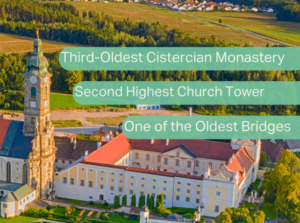Hallstatt, nestled in the stunning Salzkammergut region of Upper Austria, is a true gem recognized as a UNESCO World Heritage Site. This picturesque town, home to around 700 residents, attracts nearly one million tourists annually. With its charming lakeside setting, rich history, and breathtaking views, Hallstatt is a must-visit destination for travelers seeking both beauty and cultural depth.

Book
Austria by Public Transport
Discover Austria like never before with “Austria by Public Transport.” This book is your ultimate guide to exploring the beauty of Austria easily and affordably. Get your copy today and start your adventure!
Hallstatt, located in Upper Austria within the Salzkammergut region, is a picturesque town recognized as a UNESCO World Heritage Site. Nestled by the serene Hallstatt Lake, the town has around 700 residents. Despite its small size, Hallstatt attracts many visitors each year. With estimates ranging from 800,000 to one million tourists annually, Hallstatt’s popularity is immense. This small town’s unique charm and historical significance make it a must-visit destination for travelers from around the world. Hallstatt’s beauty, history, and charm draw visitors from far and wide, showcasing its breathtaking surroundings. Plan your visit to experience this stunning town and its captivating ambiance.

Eating out in the city can be very problematic. A large number of profit-driven restaurants offer nothing worth recommending. The best option is to eat on the hill in the Restaurant Rudolfsturm, which has only a 4.0 rating on Google Maps, but has a nice view and not the highest prices.
Also, don’t be confused by the restaurant’s opening hours.
Many of them close at different times to those listed on Google Maps, or close the kitchen an hour or two earlier – as is the case with Restaurant Rudolfsturm. It is difficult to get food after 4 pm.
We recommend that you take food with you from Vienna, the local shop has vastly overpriced products and the local bakeries also close very quickly.
A direct train runs to and from Vienna once a day. It carries a very large number of people. It is a good idea to book a seat or go to the first station in Vienna to ensure you have a seat.
On the return journey, you can choose to walk around the town to Obertraun, which also has a train station, and the train will take you back to Vienna with one change. The walk is not demanding, takes between 40 minutes and 60 minutes. There is a footpath alongside the road.
All public toilets are charged, so it is advisable to bring cash. In addition, public toilets also close at around 5 pm.
We recommend that you get to the mine using the funicular that operates in the town. On the internet, you can only book tickets for a visit to the mine, which also includes the funicular.
You can also walk to the mine, but this will take you up to two hours. The climb is very steep and requires endurance.
If you want to walk, instead of going up, we encourage you to go down.
If you buy a ticket for a specific time for the mine and the funicular, you do not have to worry much about the time. Typically, there are quite long queues to the funicular anyway. Thus, having a timed ticket ensures you don’t miss your turn. Moreover, it helps in planning your visit better. Therefore, purchasing a timed ticket can save you from unnecessary waiting.
From Vienna, it’s a good idea to take a swimsuit with you. You can swim in the lake on one of several beaches, or on one of the wilder shores. However, don’t expect a long swim, the water is usually quite cold.
Did you know?
The site you are reading is our independent project, and it takes between 10 and 20 hours to prepare one post. Therefore, if you use our website regularly, we would be grateful for your financial support. Additionally, sharing our content, inviting friends, or purchasing from our shop helps us a lot. Your support ensures that we can continue providing high-quality content for you. Thank you!
Hallstatt’s Historic Coat of Arms

The coat of arms of Hallstatt, granted in 1494 by Emperor Maximilian I, symbolizes the town’s rich history of navigation on Hallstatt Lake and the Habsburg dominion over the region. Consequently, this emblem reflects the town’s longstanding significance and its connection to the Habsburg legacy. Moreover, the coat of arms serves as a reminder of Hallstatt’s historical importance and its enduring heritage. Thus, the emblem not only honors the past but also continues to be a proud symbol for the residents of Hallstatt.
Highlights of Hallstatt
- UNESCO World Heritage Site, Hallstatt, located in Upper Austria’s Salzkammergut region, is not only a picturesque town but also recognized for its historical significance.
- With a population of approximately 700 residents, this small town attracts between 800,000 to one million tourists annually.
- The historical coat of arms of Hallstatt, granted in 1494 by Emperor Maximilian I, not only symbolizes its rich history but also reflects its strong ties to the Habsburg dynasty.
- The meaning behind the name “Hallstatt” comes from “Hall” (referring to salt mining) and “statt” (meaning town), which together highlight its historical role in the salt industry.
- Hallstätter See, a glacial lake renowned for its crystal-clear waters, also offers scenic ferry rides every half hour.
- Hallstatt’s ancient history stretches back over 250 million years, with evidence of human activity dating as far back as 12,000 BCE.
- Hallstatt Culture – Known for its salt mining and trade during the Iron Age, Hallstatt showcases artifacts and burial sites.
- In terms of modern history, a devastating fire in 1750 led to the town’s reconstruction, and as a result, shaped its current charming architecture.
- Among the must-visit sites are the Parish Church of the Assumption, St. Michael’s Chapel with its unique ossuary, and, furthermore, the historic Rudolfsturm tower.
- Until the 19th century, Hallstatt could only be reached by boat from a nearby town or mountain trails.
- In 1958, Hallstatt made history by holding Austria’s first local referendum, during which residents rejected the proposal to build a road through the town.
- Despite having 700 residents, Hallstatt suffers from overtourism, with up to a million visitors annually. Since 2020, tourism has been restricted, with only 54 buses allowed to enter daily, each paying around 80 euros and staying a minimum of 2.5 hours.
- In addition, China has a replica of Hallstatt, and it is used as a residential area for wealthy inhabitants.
- Residents of Hallstatt were not consulted about the replica in China; consequently, they discovered it by chance towards the end of its construction.
- Nearby Bad Ischl was where Emperor Francis had his residence and where he signed the treaty in 1914 that triggered World War I.
- Salzkammergut is one of Europe’s most economically active regions.
- Visitors to the salt mine can ride the longest wooden slide in Europe.
Name Hallstatt
The name “Hallstatt” uncovers the town’s historical origins in salt mining. “Hall” frequently appears in town names connected with salt mining or processing, signifying its role in this ancient industry. Conversely, “Statt” translates to “town,” emphasizing Hallstatt’s stature as a historic settlement. These elements together emphasize Hallstatt’s lasting legacy as a pivotal figure in the salt trade.

Hallstätter See
Hallstätter See is a picturesque glacial lake fed by the Traun River, one of Austria’s most famous rivers. Spanning approximately 7 km in length and 1 km in width, the lake has an average depth of 64 meters and a maximum depth of 125.20 meters. Additionally, its crystal-clear waters offer visibility up to 14 meters deep, making it a remarkable spot for water sports and swimming.
Despite its beauty, Hallstätter See remains cold throughout the year due to the inflow from the Traun River and numerous mountain streams. The temperature rarely exceeds 20 degrees Celsius. Since 1862, regular ferry services have operated on the lake. These ferries provide both locals and tourists with scenic transport across its serene waters.
Stay updated with the latest tips and interesting facts about Vienna and its surroundings! Subscribe to our newsletter for exclusive content, special offers, and much more. By joining our community today, you will never miss out on the best our site has to offer. In addition, you will receive updates directly in your inbox. Moreover, our special offers are only available to subscribers. So, sign up now and enjoy all the benefits!
History
The Ancient History of Hallstatt
The history of Hallstatt dates back approximately 250 million years. During this time, the region was submerged under a vast sea. As the sea began to dry up, it left behind deposits of salt. Over millions of years, geological movements and the shifting of rocks buried these salt deposits deep within the mountains. This ancient process laid the foundation for Hallstatt’s rich history in salt mining, which has significantly shaped the town’s heritage and development.

Ancient Humans in Hallstatt
Human activity in the Hallstatt area dates back to 12,000 BCE, with some of the oldest findings including a cave bear bone shaped by humans. These ancient artifacts emphasize the enduring presence of human settlers in the region and their relationship with the natural surroundings. As a result, Hallstatt is recognized as a site of considerable archaeological and historical significance. Moreover, these discoveries highlight the area’s diverse cultural heritage, drawing interest from historians and archaeologists alike.
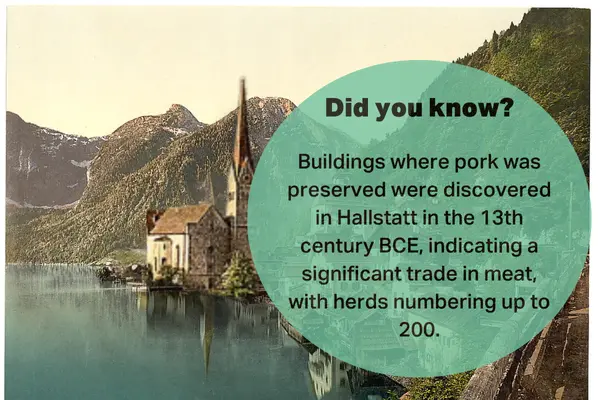
The Birth of the Hallstatt Culture
Settlement in Hallstatt took several thousand years to develop. The earliest traces of habitation in the area date back to 5,000 BCE. During this period, early hunters and fishermen ventured into the forests surrounding present-day Hallstatt in search of food. They discovered salt springs and began boiling the saline water to extract salt, which they used for preserving food, trading, and seasoning.
A thousand years after discovering the salt springs, people began industrially exploiting salt deposits. This activity led to the establishment of trade routes and exchanges. Archaeologists have found evidence of this in prehistoric cemeteries, where they discovered luxury goods from Greece and the Etruscans, as well as richly decorated weapons. These discoveries gave rise to the Hallstatt Culture, a historical era that brought fame to the town and marked it as an important archaeological site known worldwide.
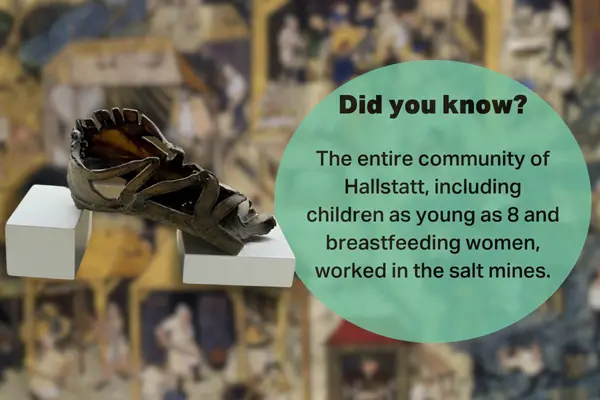
Hallstatt Through the Ages
In 400 BCE, a landslide in the salt mines of Hallstatt tragically killed several miners, causing a halt in salt extraction. By the 1st century BCE, the Roman Empire had incorporated the area of present-day Hallstatt, but salt mining likely had not resumed. After the Roman Empire fell, the Bavarians inhabited the region. Roman influence in Hallstatt lasted from 15 BCE to 54 CE.
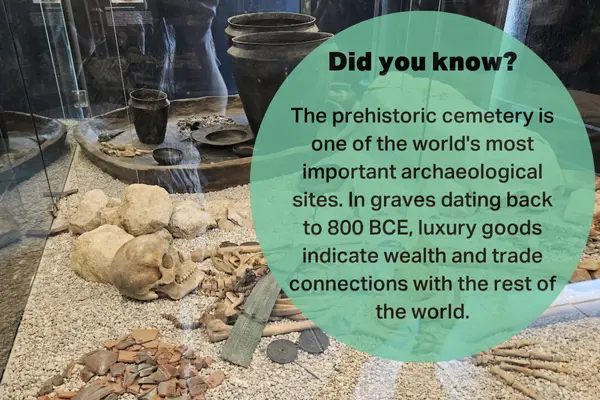
In the following centuries, the spread of Christianity and the region’s subordination to Habsburg rule began. The first church in Hallstatt is believed to have been established around the 12th century CE. In 1284, an Austrian duke ordered the construction of a defensive tower known as the “Rudolfsturm,” which now serves as a restaurant offering stunning views of the town from the mountaintop.

By 1311, Hallstatt had been granted market rights, and documents from that year confirm the resumption of salt mining in the area. In 1494, Emperor Maximilian I, one of Austria’s most renowned emperors, granted Hallstatt the right to use its own coat of arms. This marked a significant moment in the town’s history. Consequently, these events highlight Hallstatt’s historical importance and its long-standing connection to the salt mining industry. Moreover, the coat of arms symbolizes the town’s rich heritage and its significance within the region.
Thanks
Firstly, thank you for reading this post! We appreciate your time. If you enjoy our content, please consider supporting us. You can help by sharing our posts, inviting your friends to visit, or making a purchase from our shop. Your support keeps us going and helps us create more great content. Additionally, when you share our posts, it helps us reach a wider audience. Furthermore, inviting your friends to visit our site boosts our visibility. Moreover, making a purchase from our shop directly supports our work. Therefore, your support is crucial for us. Thank you!
Modern Hallstatt
The current architecture of Hallstatt is not very old, as a devastating fire in 1750 burned the town to the ground. The reconstruction of Hallstatt began soon after, shaping the charming village seen today.
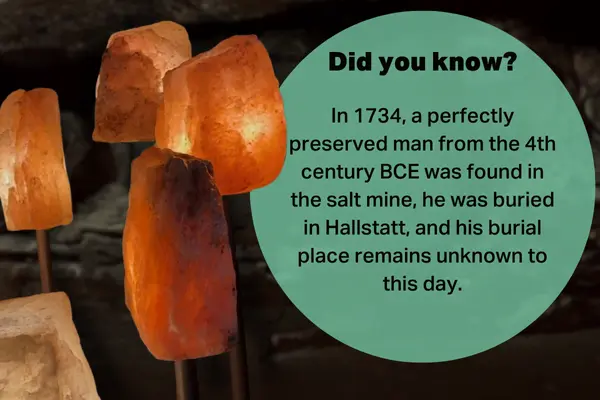
In the 20th century, the life of miners in Hallstatt was extremely tough. About 250 workers toiled in the mines, working 8-hour shifts underground or 12-hour shifts above ground, six days a week. To save time on the daily commute up the mountain, miners lived in a building adjacent to the mine. They only spent Sundays with their families, highlighting the grueling nature of their work and the sacrifices they made. Consequently, this demanding lifestyle underscores the harsh conditions miners endured and their dedication to their labor. Moreover, it reflects the strong community bonds formed through shared hardship.

Must-Visit Places in Hallstatt
The Parish Church
This stunning Roman Catholic church, perched on a steep rock in Hallstatt, Upper Austria, is a marvel of late Gothic architecture, completed in 1505. Inside, the church features two notable winged altars—one from the late Gothic period and a neo-Gothic cross altar. Visitors can admire the impressive organ, choir stalls, and intricately carved benches. Additionally, the main entrance, dating back to 1519, is adorned with beautiful frescoes, adding to the church’s historic charm. Consequently, this church is not only an architectural gem but also a significant part of Hallstatt’s rich heritage. Moreover, its artistic elements and historical significance attract many visitors each year.
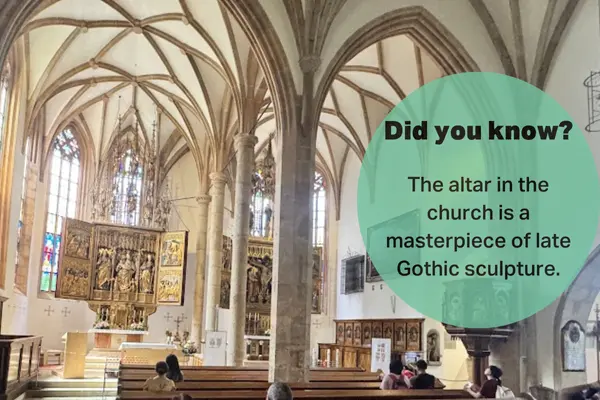
St. Michael’s Chapel
Adjacent to the Parish Church is St. Michael’s Chapel, renowned for its unique ossuary. This chapel houses over 1,200 painted skulls, a tradition born from Hallstatt’s limited cemetery space. The skulls, often decorated with names, dates, and intricate designs, provide a fascinating glimpse into the town’s history and customs. Moreover, St. Michael’s Chapel is a significant cultural and historical site, reflecting Hallstatt’s deep-rooted religious and community traditions. Additionally, visitors find the ossuary an intriguing aspect of Hallstatt’s heritage, showcasing the town’s approach to honoring its deceased. Thus, the chapel stands as a testament to the town’s unique cultural practices.

The Evangelical Church
The Evangelical Parish Church AB Hallstatt, also known as Christ Church, is a historic Protestant church in Hallstatt, Austria. Built between 1859 and 1863, it replaced a prayer house from 1785. Designed by Ludwig Lange from Munich, the church features a wooden altar and an organ made by Franz Sales Ehrlich in 1865. The church can seat 550 people and has undergone several renovations, including a roof repair from 1957-1961 and interior refurbishment in 1962. During the world wars, the church’s bells were lost, but people installed new ones in 1977.

Rudolfsturm
The Rudolfsturm in Hallstatt, Austria, originally built in the late 13th century as a defensive tower, has evolved significantly over the centuries. This historic structure, perched on the Turmkogel, offers unparalleled views of Hallstatt, Hallstätter See, and the surrounding mountains, cementing its place in the UNESCO World Heritage landscape. Initially serving as the residence for mining operation managers until 1954, the Rudolfsturm’s three-story limestone structure and strategic location highlight its medieval importance. The tower’s architecture, with a square footprint and steep shingle roof, reflects its robust medieval origins. Subsequent modifications, such as the addition of a Biedermeier-style hipped roof in 1833, showcase its adaptive evolution. Today, the Rudolfsturm functions as a gastronomic venue, drawing tourists who appreciate its historical significance and breathtaking vistas. The site’s rich history, complemented by modern amenities, makes it a prime example of successful preservation and adaptive reuse.
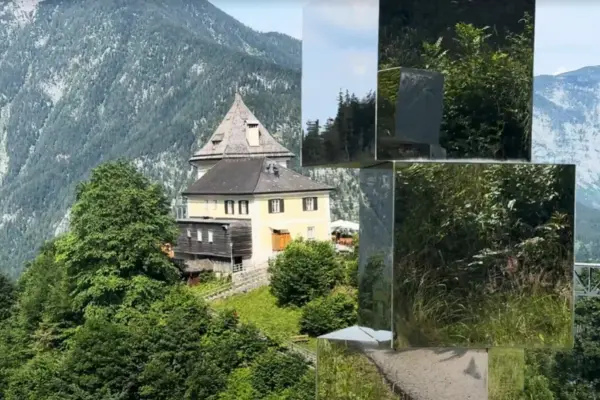
Hallstatt Brine Pipeline
The Hallstatt brine pipeline, which was built between 1595 and 1607 by order of Emperor Rudolf II, is the oldest and longest-running industrial pipeline in the world. Originally, it was made from hollow tree trunks, and it carried brine from the Hallstatt Salt Mountain to the old saltworks in Bad Ischl before reaching the new saltworks in Ebensee. By using natural slopes and piston pumps, it revolutionized salt transportation, ensuring a steady flow to the processing facilities. Today, the pipeline, which is now made from plastic pipes, remains in use and is a protected technical monument. Moreover, since 2015, the Salzalpensteig long-distance hiking trail has followed the path of these historic pipelines, connecting hikers with this fascinating part of history.
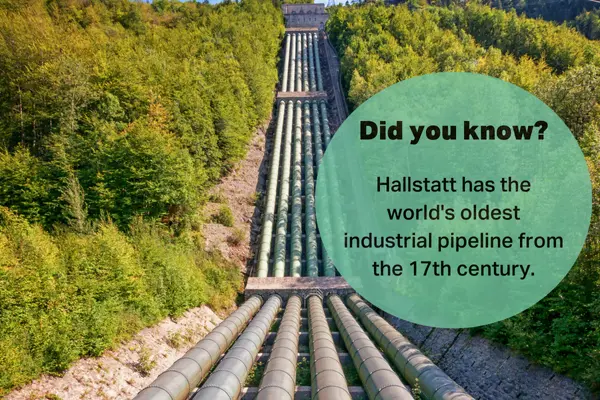
Join Our Vibrant Community
Are you passionate about discovering the hidden gems of Vienna and its surroundings? Follow us on social media and become part of our enthusiastic community!
Why Follow Us?
- Exclusive Content: Each post is a labor of love, taking between 10-30 hours to create. We share breathtaking photos, captivating stories, and invaluable tips.
- Stay Updated: Never miss out on exciting events, new attractions, and must-visit spots in and around Vienna.
- Support Independent Projects: We are an independent project, and your follows help us cover the costs of running this page. Your support is crucial!
Your Support Matters!
Every follow, like, and share directly supports our work. It helps us continue bringing you the best content and ensures we can keep this site running. By following us, you’re not just staying informed – you’re helping us grow and thrive.
Don’t miss out! Click the links above and start following us today. We can’t wait to connect with you!






